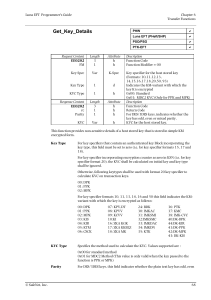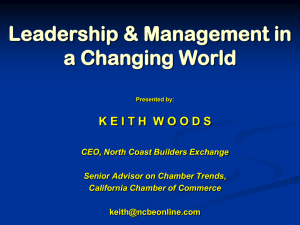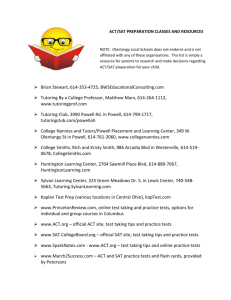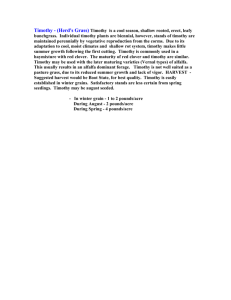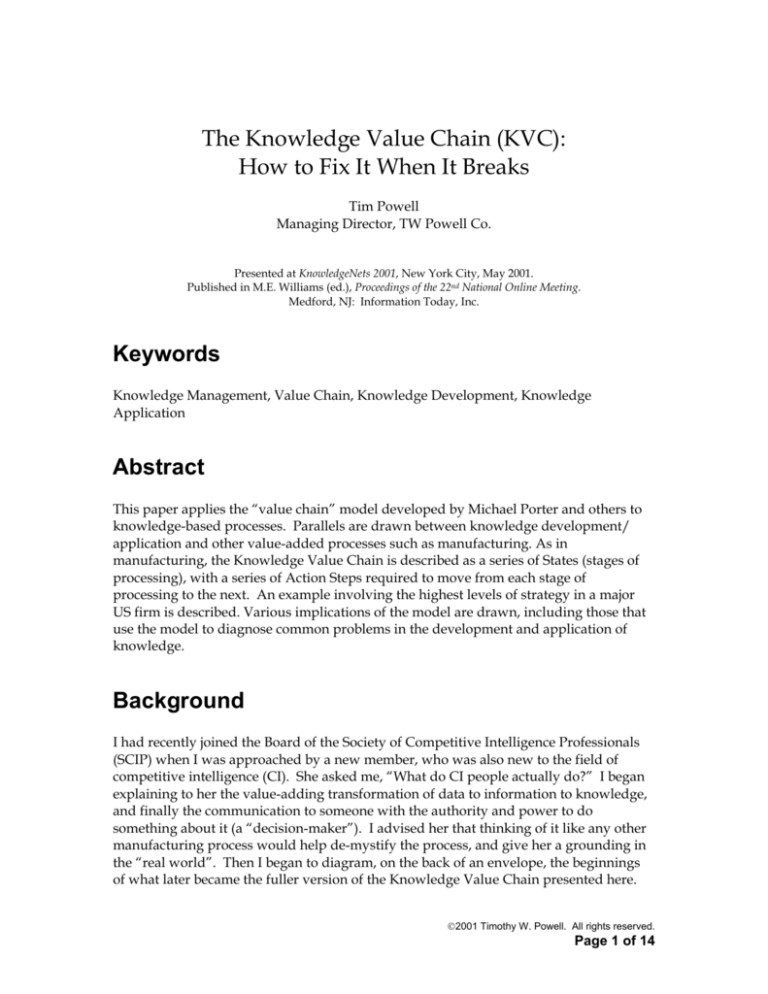
The Knowledge Value Chain (KVC):
How to Fix It When It Breaks
Tim Powell
Managing Director, TW Powell Co.
Presented at KnowledgeNets 2001, New York City, May 2001.
Published in M.E. Williams (ed.), Proceedings of the 22nd National Online Meeting.
Medford, NJ: Information Today, Inc.
Keywords
Knowledge Management, Value Chain, Knowledge Development, Knowledge
Application
Abstract
This paper applies the “value chain” model developed by Michael Porter and others to
knowledge-based processes. Parallels are drawn between knowledge development/
application and other value-added processes such as manufacturing. As in
manufacturing, the Knowledge Value Chain is described as a series of States (stages of
processing), with a series of Action Steps required to move from each stage of
processing to the next. An example involving the highest levels of strategy in a major
US firm is described. Various implications of the model are drawn, including those that
use the model to diagnose common problems in the development and application of
knowledge.
Background
I had recently joined the Board of the Society of Competitive Intelligence Professionals
(SCIP) when I was approached by a new member, who was also new to the field of
competitive intelligence (CI). She asked me, “What do CI people actually do?” I began
explaining to her the value-adding transformation of data to information to knowledge,
and finally the communication to someone with the authority and power to do
something about it (a “decision-maker”). I advised her that thinking of it like any other
manufacturing process would help de-mystify the process, and give her a grounding in
the “real world”. Then I began to diagram, on the back of an envelope, the beginnings
of what later became the fuller version of the Knowledge Value Chain presented here.
2001 Timothy W. Powell. All rights reserved.
Page 1 of 14
Introduction
Virtually all of us reading these words are “knowledge workers”—in doing our jobs, we
read articles and journals, search databases, talk to people, think about and summarize
what we’ve found, and communicate our findings to decision-makers. But the process by
which this occurs is not well-defined or understood, either by cognitive scientists or by
business process experts. Yet, the knowledge-creating process stands at the heart of
modern organizational competitiveness.
We must understand the knowledge process before we can attempt to improve on it.
We must peer into the “black box” of knowledge work and attempt to see what is inside,
and how it works. Why? Simply put, the productivity of the knowledge worker is seen
by experts1 as the single most important factor in the competitiveness of the modern
organization. And productivity is best enhanced when work processes are broken into
their basic elements.2
We must find some way to turn information into business value. Stated that way, this
transformation sounds magical, like the transformation of lead into gold that the
medieval alchemists struggled to achieve. Let’s not forget that their struggle, though
ultimately futile, did produce the body of knowledge that eventually became modern
chemistry. That’s because they began to document, test, and refine each micro-process
that led in the direction of their final goal, and to assemble those “micro-learnings” into
a larger body of knowledge.
That is what we will begin to do here. I should point out that this thinking builds on the
work of others. And I hope it will not be the last word on this subject, as any model of
this nature needs challenging and refining before it becomes truly useful. As such, I
claim no proprietary right to this term Knowledge Value Chain, and in fact hope it will
be widely adopted.
Definitions
In defining the Knowledge Value Chain, we need to define each term that goes into it.
Let’s start in the middle, and work our way out.
Creating value is ultimately what organizations are all about. In business, we measure
value by a number of metrics, each of which is valid when used in the right context.
These include:
financial measures like revenues and profits;
stock price (known in polite circles as “shareholder value”);
innovation, for example the number of new patents granted;
2001 Timothy W. Powell. All rights reserved.
Page 2 of 14
other more complex and sophisticated measures such as the Balanced Scorecard
developed by Nolan and Norton, and Economic Value Added (EVA)
developed by Stern and Stewart. These include a mix of measures like customer
satisfaction and production quality.
Non-business organizations have similar measures of effectiveness and efficiency.
The value chain model was
popularized by Michael Porter
in his 1985 book Competitive
Advantage3. We’ll define it here
as a series of related activities that
Figure 1: A Simple Value Chain
together produce end-user benefits.4
A simple example of a value chain
is manufacturing. Here there is a defined series of steps in which raw materials are
transformed into work-in-process at various stages of completion, and then into finished
goods ready to be packaged and shipped. Each stage of processing adds both costs and
value (defined here as the purchase price paid by the end user.) Each step should add
more value than cost—and if not, that step needs to be re-engineered in some way.
An illustration from everyday life is painting your apartment or house before you try to
sell it. People usually do this, as typically the cost of doing so is less than the value
added—even if the new owner intends to repaint before moving in.
The knowledge value chain is simply the application of the value chain model to
knowledge development and usage. In short, it is a process model of how data becomes
intelligence, and eventually becomes part of a business result or benefit. The balance of
this paper will define this KVC process.
The Knowledge Value Chain
The knowledge value chain (KVC) comprises two major sets of activities, knowledge
acquisition and knowledge application. This reflects the division of labor in knowledge
work that has evolved in large, complex organizations. Here, knowledge workers are
primarily tasked with knowledge acquisition and development, and decision-makers
apply the resulting knowledge to make better business decisions, plan and execute
actions, and thereby achieve business results.
The KVC model contains an alternating series of “states” and “actions”. Each state is a
stage of processing, a work-in-process like a partially-built car would be in an auto factory.
Each action is the transformation needed to move to the next stage of processing.
There are a total of eight process states and seven key transformations or action steps.
Each action step has as its “input” the state preceding it, and as its “output” the state
following it. Each of the seven steps is an opportunity to add value—or to fail to do so,
2001 Timothy W. Powell. All rights reserved.
Page 3 of 14
or even destroy value, if it is omitted or executed poorly. Each step is thus a potential
fail point, at which we need to be asking whether we are controlling quality.
4
6
Figure 2: The Knowledge Value Chain
(KVC)
The KVC model starts with a
shared understanding between the
knowledge worker and decisionmaker. The quality of this step is
essential to the whole rest of the
process. If this part is flawed (for
example, rushed--or skipped
entirely), the remainder of the
process cannot achieve the level
of value-enhancement possible.
To use our car manufacturing
analogy, in some cases great
expense and time are spent
designing and manufacturing cars
that ultimately fail in the
marketplace because the
“decisions maker” (that is, the
consumer) does not want them.
By contrast, the Ford Taurus is
legendary in automobile history
for two reasons: (1) it was one of
the best-selling models year after
year, and (2) massive amounts of
consumer research went into
defining the car’s features before
it was even designed.
In the world of business research,
an example of a lack of shared
understanding is when you
spend a lot of time researching a problem
that turns out not to warrant the urgency
you gave it.
Both examples derive from a failure to achieve shared understanding at the outset. This
understanding should include the basic project parameters, such as:
the time frame,
the budget (if any),
the use that is to be made of the information, and
any sensitivities that may exist around the project.
2001 Timothy W. Powell. All rights reserved.
Page 4 of 14
Action Step 1. Acquire Data
Then, and only then, can the knowledge worker go off and begin to acquire data. Data
are the equivalent of “fact and figures”, the points around which we will eventually
build our analysis. (When we say acquire, we are speaking of any method of obtaining
data, including but not limited to its purchase for a fee.) This can involve speaking to
people on the phone, going online, looking at printed sources, and so on. (Exactly
where and how to acquire data is a long discussion – refer to Analyzing the
Competition, for example.)
Given the proliferation of data that exists, as often as not this step involves selecting and
filtering a bounded set of data from a much larger data universe.
Having acquired the data, then the analysis can begin…almost.
Action Step 2. Process Data
But first, in my experience there is usually an interim step that involves processing or
organizing the data—preparing it so that it can be analyzed properly. This step
frequently involves entering data into a computer. For example, handwritten notes from
an audiotape of a phone conversation might need to be transcribed into a word
processor before they can be analyzed. Numeric data points can be entered into a
spreadsheet, and trends lines and charts drawn. Publications in a foreign language must
be translated into the analyst’s native tongue. Facts need to be checked and validated.
“Outliers”—data points that lie far outside the general trend of the data—need to be
examined, and decisions made as to whether they are valid and should be included, or
whether they are spurious and should be dropped.
Action Step 3. Analyze Information
The processed data is called information, and only now it is ready to be analyzed. During
the analysis phase, we transform information into knowledge in the following ways:
by giving it context—what are the circumstances surrounding it?
by assessing its relevance to our organization—what does it mean for us?
by drawing implications for action—what do we recommend be done about it?
by outlining options and alternatives, and
by reducing the amount of information to an amount able to be understood and
acted on by the decision-maker. In this fast-paced world, attention and focus are
two very precious commodities in the world of even the highest-bandwidth
decision-maker, and it is the analyst’s job to produce both.
2001 Timothy W. Powell. All rights reserved.
Page 5 of 14
Action Step 4. Communicate Knowledge
In this most crucial step, knowledge that heretofore has been in the mind of the
knowledge worker is transmitted to a decision maker (or, more typically, decisionmaking group). This typically happens by a combination of means including e-mails,
formal written reports, slide presentations, and personal briefings. In effect, this step
replicates the knowledge-building process in other individuals grappling with some
business problem. Here, though, the process must be accelerated and concentrated.
A successful communication gives the right amount of material, summarized and
organized well, and with analysis, conclusions, recommendations, data sources, and any
qualifications needed on the quality of the data or likelihood of outcomes predicted (“If
presents trends continue…”, “Experts predict that…”, etc.) A successful communication
produces insight in the decision-makers, and credibility for the knowledge worker.
This transferred knowledge is now intelligence, defined as knowledge in the hands of
someone with the capability of acting on it. Once this hand-off to a decision-maker is made,
too often a knowledge worker will consider the job done—and in an active sense this is
true. But in the sense of value-creation, the process to this point has not created business
value, since nothing has yet been accomplished with the information.
Knowledge workers who seek to improve their effectiveness need to know what
happens after this knowledge transfer. Only by knowing what is done with the
knowledge that we give to decision-makers will we be able to improve our work
product and processes. Just as market researchers find out what happens to products
once they go into usage, the knowledge worker needs to understand the process after
he/she is directly involved.
Action Step 5. Apply Intelligence
Decision-makers do just that, take intelligence, and use it to make decisions for the
organization, most often in a group setting. These decisions typically involve resource
allocations—where to invest, where to pull back, etc.
A key factor in any decision is when to make it. Some decisions are time-driven, for
example budget decisions. Others are event-driven, for example, what to do when a key
executive resigns. Other decisions are neither time- nor event-driven, but are driven by
change in some variable, for example a falloff in sales. Absent a pre-defined threshold
condition (for example, review sales if they fall by 5% or more), these latter decisions are
problematic precisely because it is not clear when they need to be made.
The process we have described so far is a formal decision-making process. Study after
study has shown that, while such formal processes are often involved in any major
decision, there are also typically informal inputs. These can include the decision-
2001 Timothy W. Powell. All rights reserved.
Page 6 of 14
maker’s former experiences, informal sources such as a spouse or neighbor, intuition,
and a whole host of “externalities” such as political factors.
Significant barriers can come between the presentation of good intelligence and its
application. Failures to apply intelligence can include ego (“Not invented here”), group
pressure (“They all think it’s the way to go, maybe they’re right”), and what they
psychologists call cognitive dissonance (“Don’t confuse me with the facts”).
Action Step 6. Formulate Action
We are getting closer to the end results, but are not there yet. We need to plan and
execute some actions that embody the decision. This step is a major source of
“disconnects” in the KVC. For example, in the US our lawmakers and the courts stop at
decision-making, and leave it to an army of federal agencies to try to implement their
decisions. Even when a good decision is made, it can be rendered totally ineffective by
poor actions planned to implement it.
Action Step 7. Implement Actions
Now the actual implementation of the decision and resulting action plan begins.
Resources must be committed, goals and timetables must be set, and some agency for
monitoring the results must be devised. Now, and only now, are we in a position to
gain business results from our original knowledge work.
This is also a key chance to gain some new data. Note the dotted-line feedback loop in
the diagram above. As implementation goes forth, there is an opportunity to gather
data of a typically higher quality than in preceding stages. This feedback needs to be
put into the cycle at the top, and analyzed quickly in order to provide a “course
correction” to the whole process.
For example, the credit card company Capital One is known to have an extremely
effective marketing operation built on direct mail. While all the card companies do a lot
of direct mail, Capitol One has gotten really good at doing many focused tests (“Would
people in zip code 10014 who recently bought new computers be interested in our
card?”) The results of these tests are fed back in order to continually refine the whole
process.
A KVC Illustration
We can use the mnemonic “SDIKI-DAR” (rhymes with “sticky tar”) to guide us through
the KVC process. As an illustration, let’s apply the KVC model to a company’s decision
to acquire another. Shared understanding could include a basic definition of the
characteristics of a target company of interest—industry, revenues, profitability, market
2001 Timothy W. Powell. All rights reserved.
Page 7 of 14
share, distribution, etc. Data might include the stock price and trading volume of a
potential target. Information (processed data) would include trends lines, arrays, and
graphs built out of this data. Knowledge could include, for example, correlations between
the stock price and volume trends with news about the company, and with conditions in
the market in general.
Intelligence would result from the analyst’s bringing all of this data to the attention of a
decision-maker. A decision could result to make an offer to acquire the target company.
An action plan would be formulated to define the terms, process, and support players for
the acquisition. The ultimate result would include the impact of the acquisition on
earnings per share and stock price, and the acquiring company’s market share in the
affected market.
Typical KVC Disorders
As mentioned earlier, the point of understanding the KVC process in detail is to be able
to fine-tune it and fix it when broken. I’ve recently had the opportunity to study
competitive knowledge development in a wide range of organizations and industries.
In doing so, I’ve been struck by the fact that knowledge workers across industries and
geographies have an amazingly similar set of challenges and problems. I believe that
many of these can be readily understood and corrected by using KVC analysis. Several
examples follow.
PROBLEM: “We don’t know what management wants.” This is a common complaint of
knowledge workers. Clearly this is an “Action Step 0” problem (that is, pre-shared
understanding) because there has been an inadequate dialogue between knowledge
worker and decision-maker. As a result, the data to be acquired can’t be defined
properly, and the whole chain spins off its axle. The reader may chuckle at the words
“inadequate dialogue” – indeed, dialogue glorifies what is often an eleventh-hour frantic
phone call for help.
SOLUTION: Make sure a true exchange happens before data collection starts. Define the project
parameters listed above. Use a checklist if you’re afraid you’ll forget something. As a rule,
project misunderstandings are best had up front, so they can be corrected early.
PROBLEM: “We have piles of data—but never enough time to analyze it.” This is an analysis
(Action Step 3) problem, and commonly results from the rush to complete projects. If
you fail to process and/or analyze data, you will be tempted to provide unprocessed,
un-analyzed data or information to a decision-maker. This reduces the value of the
communication, and if done repeatedly calls your credibility as a knowledge worker
into question. You must add value though analysis—though it is always good to
separately identify “the facts” from your analysis of them.
SOLUTION: In planning the project, be sure to allow adequate time for processing and analysis.
Back-time from the “deliverable” deadline, including the final production, and the analysis to get
to the results. Always allow some “slip time”, as Murphy’s Law is alive and well. (“If
something can go wrong, it will. If something cannot possibly go wrong, it still will.”)
2001 Timothy W. Powell. All rights reserved.
Page 8 of 14
PROBLEM: “We do great analysis—but management doesn’t use it.” This communication
(Action Step 4) problem results when credibility has not yet been established, or the
relationship with the decision-maker has been damaged in some way. Creating a
positive relationship and ongoing dialogue with decision-makers is one of the most
difficult and important challenges in any knowledge-based process. Knowledge
workers and decision-makers co-exist across a cultural gap that often impedes their
communications. Almost everything about them is different. They typically are trained
differently, paid differently, dress differently, live and work in different places, and so
on. The need for and difficulty of bridging that cultural gap, and to gain trust and
credibility, is often underestimated.
SOLUTION: Do some “market research” with your decision-maker clients. Determine what
they find most effective in terms of content, format, and medium of communication. Follow up
on projects—what was most useful, what was least useful, what needs to be improved.
PROBLEM: “We do great analysis—but management keeps asking for more.” This is an
Action Step 5 problem (decision), in that decision-makers may feel that they need a
greater level of certainty before making a decision. As a rule, the greater the level of
resources to be allocated based on the decision, the greater the level of certainty that
decision-makers will seek. But, paradoxically, a good data collection and analysis effort
often raises as many questions as it answers. This leads to the apparent need for more
information. Typically, though, the costs and time to produce new analysis (and
especially new data) are underestimated, and can impede the smooth flow of decisionmaking. This can lead to the situation commonly known as “paralysis by analysis”.
SOLUTION: Raise the sensitivity to the trade-offs between greater certainty, and greater time,
effort, and budget expended. Keep the flow of events moving forward toward decision-making.
PROBLEM: “Once we go into implementation mode, we stop collecting data.” The feedback
loop (post-KVC) is often ignored, thereby cutting off a source of real-world validation
and course-correction for the original decision. The problem may be an organizational
one—the issue is handed off from a “research and development” team to an
“implementation team”. The latter is less familiar with data collection, may not have the
resources for it, and generally does not have the cultural bias toward information
gathering that the research people do.
SOLUTION: Create an ongoing, active communications linkage between the research and
implementation teams. Encourage the feeding back of new data into the KVC.
PROBLEM: “We have many KVCs—but they don’t link with each other.” One key difference
between the KVC process and a physical manufacturing process stems from the
intangible nature of the KVC “products.” In an auto factory, once a bolt has been used
in one car, it obviously can’t be used in other. But data and information are “nonwasting” assets, they don’t get “used up” when used. As such they are infinitely reusable. Data used in one KVC can be used in another somewhere down the road—and
often should be. Too often this doesn’t happen due to the boundaries of time or
organizational structure.
2001 Timothy W. Powell. All rights reserved.
Page 9 of 14
I recently conducted a knowledge development workshop with a major pharmaceuticals
company. In one of the group exercises, we determined that the competitive product
information gathered by scientists at the beginning of the drug development process
stayed in the R&D unit. We discovered that many months later, when the drug had
completed development, testing, and approval, the same data could be useful to the
sales force tasked with moving the product into doctors’ offices.
We transferred the same data (comparative drug effectiveness) from the R&D teams to
the sales teams. Building this simple linkage saved the re-creation of the information at
a later time and different context.
SOLUTION: Create a macro-view of the various knowledge chains in your organization. Look
for opportunities to re-deploy data in ways that enhance value.
A Tragic Example
Over time, the misuse of knowledge can erode the fundamental value created by a
business. A recent example, tragic in its proportions, comes from the Xerox
Corporation.
Until recently, Xerox was considered a paragon of corporate practice in many respects.
For example, they pioneered some competitive applications of information—the modern
practice of benchmarking was perfected there.
Lately, Xerox stock has recently been trading at a fraction of its recent high, has
developed serious credit problems, and has repeatedly been rumored to be going
bankrupt.
Xerox’s organizational use of knowledge is at the core of their fall from grace. During
the 1970s, scientists at their Palo Alto Research Center (PARC) were responsible for a
stunning series of key inventions of the digital age: the laser printer (1971); ethernet
(1973); the graphic user interface (1975); the personal computer (1977); and the portable
computer (1978).5 Yet in every single case, they were ultimately unable to use these
inventions to create a dominant position in the commercial marketplace. What’s worse,
in each case another company was able to do so. For example, Steve Job’s emulation of
the Xerox Star computer user interface technology in the Apple Macintosh is now
legend. IBM (now Lexmark) and Hewlett-Packard took most of the share of the laser
printer market. Ethernet was commercialized by Intel, Digital, and 3Com.
The Xerox problem was a variation on the knowledge worker-decision maker gap
described earlier. The scientists at PARC were removed from the company’s primary
decision-makers both physically and culturally. The PARC scientists had a shirt-sleeve
Silicon Valley culture long before it was fashionable in the East, and were driven by
creativity—and even fun. The Stamford, CT decision makers worked in a blue-chip,
button-down, bottom-line environment. They were skeptical of the new ideas from the
2001 Timothy W. Powell. All rights reserved.
Page 10 of 14
Wild Westerners, and ultimately refused to fund the commercial development of these
key technologies.
This series of decisions not to enter new markets, overlaid with drastically changing
conditions in Xerox’s core copier market, created long-term strategic problems from
which the company may never recover.
Key Implications
Now that we understand the KVC process in principle, how can we apply it to solve
problems? What lessons and implications can we draw? Some of these are as follows:
Knowledge is a linear process. In contrast to some “cyclical” models of knowledge
development, KVC is a linear model. Like manufacturing, it uses a series of
steps to define a final product. The key lesson here is that you must understand the
destination before you start the journey. And that destination is not simply the
approval of your decision-maker client (though that may be a good real-world
proxy for the true payoff.) The true payoff is the final business condition that
will result from the whole process.
Knowledge is a serial process. These states and actions are “wired in series”.
Picture those holiday lights on strings, where when one goes out, the whole
string goes out. Likewise, here, when one link in the value chain is broken, by
definition the chain itself is broken. A failure at any step is replicated in all later
steps. For example, a great analysis of faulty data will produce a misguided
conclusion. The old adage “garbage in, garbage out” makes this point very
succinctly.
Each step in the KVC is integral and essential. If you short-circuit the process
(which you might be tempted to do, to save time or other resources), you will fail
to create value—or possibly even destroy value. The classic example is when a
decision is made without sufficient information to support it. The result is more
a matter of luck than of strategic management. While it is possible to succeed in
the short term under these conditions, over the long haul the odds are stacked
heavily against doing it repeatedly.
Knowledge value chains interact. In the pharmaceuticals case mentioned above, a
single data set was employed in two otherwise separate KVCs. You need to map
out these various KVC processes, formally if possible, in order to identify and
improve these interactions. As an example, when you finish a project for a
decision-maker, it is helpful to routinely inquire as to who else would find the
information useful (with, of course, your client’s advice and consent.)
2001 Timothy W. Powell. All rights reserved.
Page 11 of 14
Knowledge creation is like manufacturing. I state this here as a conclusion, though
admittedly it was more accurately a hypothesis going into this series of
propositions. However, to the extent that it is true, we can then use the many
insights into manufacturing that have been gathered by students of that
discipline.
Manufacturing concepts that we can “borrow” in the study of knowledge-based
processes include:
Incremental value added. Each of the seven transformation steps can be
deconstructed, and some assessment made of its incremental cost and valueadded. Though it may not be possible to do this on a strictly quantitative basis,
at least at first, the exercise will still yield important insights.
Productivity. The productivity of knowledge-based processes is a primary aspect
of competitive differentiation. In manufacturing, it can be measured the by ratio
of input to output (for example, person-hours to produce an automobile.) Again,
the measure for knowledge-based processes may be a lot more “fuzzy” at this
stage than it is for manufacturing, but the model may prove as valuable.
Quality assurance. Just as in manufacturing, quality can be built into the process.
The alternative can be to find out when a complete study has been done, and
resources expended, that they are the right answers—but to the wrong questions.
One form of quality assurance, for example, can be establishing frequent touchpoints with the decision-maker on the project status (from both sides.) This will
avoid any “process surprises.”
Load balancing. Too often a knowledge process is off-balance in terms of resource
assignments. A common example is that too much time is devoted to data
collection, and too little to analysis and communications. Load balancing enables
you to identify and clear the bottlenecks that may be dragging down the whole
process, and to re-allocate resources in order to clear those bottlenecks.
Just-in-time (JIT). JIT manufacturing came into vogue because associated with
each raw material and purchased component, there is a cost of inventory
(typically, the financing cost of purchasing the items, plus the cost of the physical
warehouse space in which it is kept.) For information, the inventory cost is
typically not the “warehousing” cost—though there may be some cost associated
with physical document storage and magnetic media such as hard drives.
The main cost associated with information is its obsolescence cost—its inexorable
tendency to become less representative of the “real world”, hence less valuable,
over time. Any piece of produced information begins to “decay” as soon as it is
produced. Some information decays rapidly (“Who wants yesterdays’ paper?”),
some less rapidly.
2001 Timothy W. Powell. All rights reserved.
Page 12 of 14
As a result, it is useful to consider production of knowledge at the last possible
moment of knowledge, to minimize the risk of obsolescence. (Come to think of
it, maybe that’s the reason for all those last-minute information requests!)
Inventory. The view of information as a highly perishable asset, like fresh fish,
raises other considerations. Issues include: which information should we keep
“in inventory”; which should we produce on demand; what is the current value
of what we have in inventory; etc. The nature of the inventory can vary, for
example, a current list of print sources may prove nearly as valuable as having
the sources themselves--assuming those sources are readily retrievable when
needed.
Auditing. Physical inventories of raw materials, work-in-process, and finished
goods are subjected to periodic structured verification processes called audits—
and our knowledge inventory should be, too. In this way you can determine
what you have, what condition it is in, what you have too much of, what gaps
there are, and so on.
Though information is different from other assets in key respects (primarily, its
intangibility and re-usability), it is nonetheless useful to consider those ways in which it
is similar to other assets. In this way, many pre-existing management models, some of
which are listed above, can be brought to bear on the strategic problem of knowledge
productivity.
Conclusion
“The purpose of information is not knowledge. It is being able to take the right action.”6
Too often knowledge workers limit themselves to the production and distribution of
knowledge, without considering how it creates value for the organization. This key
omission threatens the value of knowledge work—and the careers who perpetuate this
way of thinking.
We have presented the Knowledge Value Chain model in the hopes that it will spur
enhancements in the productivity of knowledge processes—the key determinant of
organizational competitiveness. We do not intend it as a theoretical model, but rather
for use on the “front lines” of knowledge about knowledge—in diagnosing and fixing
problems.
2001 Timothy W. Powell. All rights reserved.
Page 13 of 14
Notes
1 For example, Peter Drucker: “Fifty years from now—if not much sooner—the leadership in the
world economy will have moved to the countries and to the industries that have most
systematically and most successfully raised knowledge-worker productivity.” In Management
Challenges for the 21st Century, Harper Business, 1999, page 158. I believe the same statement will
be applicable to companies and individuals as well, and that the time frame will be considerably
shorter than 50 years.
2 Frederick Taylor did this for industrial work. See Andrea Gabor, The Capitalist Philosophers,
Times Business, 2000.
3 Michael Porter, Competitive Advantage, Free Press, 1985.
4 Note that this is similar to the definition of a business process, and indeed the concepts are closely
related.
5 Michael Hiltzik, Dealers of Lightning, Harper Business, 1999.
6 Drucker, op. cit., page 130.
2001 Timothy W. Powell. All rights reserved.
Page 14 of 14

